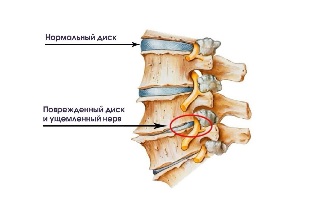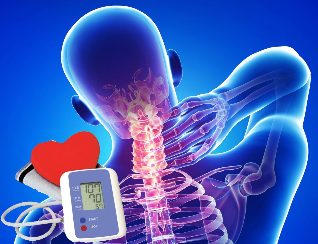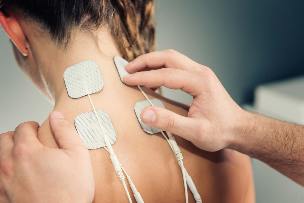Cervical osteochondrosis is a dystrophic changes of the intervertebral discs in the neck.

A negative impact not only on the plates affect it, but also the vertebrae cartilage and soft tissue. The most important cervical spine feature is the fact that its vertebrae have not the most reliable structure compared to the department of muiden, which makes the area very vulnerable. The vertebrae here are located close to each other and the blood vessels that carry people power in the brain.
If there is displacement of the vertebrae, compression of the nerve causes the possibility and blood vessels, which will inevitably go to the occurrence of a hernia between vertebrae to bulge, i.e. the structure of and changes in the spinal disc.
What is it?
Osteochondrosis of the cervical spine (Osteohondroz) is a degenerative-dystrophic lesions of the intervertebral discs, which is the damaged disc, the vertebrae and joints of the cervical, lower the height of the intervertebral discs. If untreated, the Disease progresses and can cause headaches, circulatory problems and even hernia. Like osteoporosis, the disease paid because of disorders of mineral metabolism, causing the bones of the joints become and the less strong.
Osteochondrosis can cause instability of the cervical spine (the symptoms treatment and are similar to the chondrosis, but has a number of features), which is often associated with displacement of the vertebrae. This in turn accelerates the development of degenerative disc disease, destroying the backbone of the Department.
Step
The treating physician should determine the extent to which the development of cervical degenerative disc disease based on medical history physical examination of the patient and perform. Separated for four at:
- Published for the first degree. The disease is in the Bud, the patient has mild pain in the neck, which can be more intense, if the person starts to turn his head.
- In the second degree. The patient may complain of very severe pain in the cervical spine, which can be localized to the upper extremities. The clinical picture shows that at this stage of the disease development is observed in the compression of the nerve fibers, causing severe pain. Also has a key role in environmental, headache, weakness and General malaise.
- The third degree. The pain becomes almost continuous, the radiation should also be in the shoulder or arm. Some patients diagnosed with hernia of the intervertebral discs, which leads to numbness of the upper limb. During the medical examination there is a noticeable decrease in the mobility of the cervix, and pain on palpation.
- In the fourth degree. This stage of the disease the intervertebral disc is almost completely destroyed. In its place is the connective tissue, which leads to deterioration of the patient. He began to feel pain, noise in the head and bad education student riekkinen has been working in space. This suggests that the artery on top attached, which prevents the natural power of the brain.

Symptoms of degenerative disc disease is cervical
The main symptoms of degenerative are disc disease of the cervical spine, dizziness, headaches, blood pressure jumps.
Diagnosis of the disease difficult, sometimes non-obvious pain, and the symptoms disappear brand, in addition, the uncontrolled use of strong pain medicines mask symptoms. The patient may feel the pain, feel healthy, and this continued until the development of irreversible processes in the tissues of the joints of the neck.
Headache in cervical osteochondrosis
This is one of the most common non-specific signs of many diseases. Headaches are especially common women. It is difficult to determine the cause of headaches, and combine it in addition to the damage to the spine. There are 14 different reasons for headache in humans.
The most common causes of headaches described in the pathology:
- Spasms of cerebral vessels;
- Pinched nerve roots;
- A reflex increase in intracranial pressure.
Headache in cervical osteochondrosis can remember the feeling, when hypertension, angina pectoris, or stroke. In particular, middle-and older age, usually the risks of developing strokes or heart attacks.
Feel that can be a pain paroxysmal, persistent, pulsating, and boring.
When heart disease, patients complain of discomfort in the chest, accompanied by a rhythm disturbance of the heart. To identify the cause of unnecessary qualified doctor. If the headache combined with nausea, dizziness and chest pain, make sure of the ECG.

Dizziness with cervical osteochondrosis
This condition is not always clearly demonstrated degenerative disc disease of the cervical spine.
Dizziness can be caused by:
- Inflammation near or in the inner ear;
- Spasms of cerebral vessels;
- Violations transmission of nerve impulses;
- Problems with the vestibular apparatus;
- Diseases of the cardiovascular system.
There are no clear criteria, dizziness osteochondrosis. However, systemic still there and non-systemic dizziness, they have clear differences.
Know It is recommended systemic differences and non-systemic dizziness, this will help determine the causes of unusual States:
- System vertigo is a sense of circular motion of the surrounding objects or the body, which is the result of disruption of the vestibular apparatus, visual and analyzer are receptors in joints, muscles, and skin (lower back pain of various etiologies);
- Non-systemic dizziness is a feeling, fainting, feeling shocked, uncertain state in an upright position. When the not-for-bulking-systemic dizziness circular rotation is missing, and this is the main difference compared to brands.
People who feel dizzy to one particular type should be checked by an experienced doctor, primarily a neurologist or (if there is a suspicion of disease of the ear field, and throat) an otolaryngologist.
The reason for hospitalization, the emergency is not related to degenerative disc disease of the cervical spine, have the patient identifying information (except the dizziness) of such mark by:
- Facial paralysis and a comfortable shoulder strap;
- Severe headache on the background of deterioration of health;
- Violation of coordination of movements;
- Loss or consciousness loss.

Blood pressure, cervical osteochondrosis
The ratio of cervical degenerative disease, irregular blood pressure plate has long been established. The cervical vertebrae are important of nerve endings and blood vessels.
Characteristic pressure changes during the day. Hypertension for a long time not typical for this disease. Reflex irritation of the nerve endings and the short-term spasms of the blood vessels, causing a sudden the clock the dynamics of hypertension.
Features elevated cervical osteochondrosis is a combination of the following symptoms:
- Headache;
- Pain and limbs in the chest;
- To reduce the sensitivity of the neck area;
- The occurrence of pressure peak after stress, muscle tension, prolonged stay in an uncomfortable position and other similar situations.
These features should be taken into consideration-it-it-differentiation of arterial hypertension of different Genesis.
Spikes HELL and health are the rapid deterioration of the foundation seek immediate medical help.
Syndromes of osteochondrosis
The clinical picture of cervical degenerative disc disease fit into a few syndromes. Syndrome this is multiple symptoms that occur together.
Low back pain consists of the following syndromes:
- Vertebrae. It is also called the spine, which indicates that involved in the pathological process and the cartilage of the bone. This leads to the formation of such symptoms: restriction of motor activity of the neck, pain when it bends, radiological changes in the image of the cervical spine. It is the simultaneous appearance of these symptoms is vertebral syndrome. A similar set of clinical signs is observed in myositis (pathology of muscle tissue) and create a painful, companion of many other diseases.
- Syndrome vertebral artery. Appears, when participation in the vascular bundles, which are responsible for the blood of the son flow to the tissues of the central nervous system. The symptoms suggests that the brainstem has stopped to get the right amount of nutrients. How to recognize this syndrome? The first mark of are dizziness, feeling in the ears, blood pressure changes, the emergence of a "veil" before the eyes. This suggests that one of the vertebral arteries stavlennia is in order. Each ship has its own nerve endings. If you squeeze them, which will innervate the vertebral artery appear, headache, numbness, transient loss of vision on one side. Vascular changes lead in the End to the fact that the brain needs oxygen. At the moment, the person feels drowsiness, transient impairment of consciousness to lose focus and control, worst, works, and other information. Such a clinical picture is differentiated cervical degenerative disc disease atherosclerosis of the vertebral arteries, and compression of the tumor or inflammation.
- Heart syndrome. Burning in the chest see you, and shortness of breath. A man realizes his frequent palpitations, tired and become irritable. This model is typical of heart disease for example angina, coronary syndrome, heart attack. The exact conclusion about the cause of such symptoms can be done after the patient ELECTROCARDIOGRAM.
- Radicular syndrome. In the cervical innervated 8 pairs of nerves, each of which have roots place nerve remove the spine. Their involvement in osteochondrosis, the patient has reduced sensitivity or vice versa pain. You may experience numbness in the neck, if his soreness, reduced sensation of the tongue, behind the ear, pain in the supraclavicular area. Sometimes there are swallowing disorders, movements of the upper limb, numbness in the fingers.
First aid at home during exacerbation of osteochondrosis
When severe pain, you can use painkillers such as Analgin, Tempalgin or Baralgina. The above-mentioned medicinal products If they don't bring relief, you can take Nsaids (Nise or Diclofenac).
Often used "diversionary" for example, means that the Capsicum plaster, which is not a cure, but in vain heats up the sore areas and take attention of pain. In that case, the formation of edema in the area of inflammation, the patient may drink infusion of herbs or diuretic for 3-4 days. It is possible to cure osteochondrosis, such a method? However, these measures are unnecessary, temporary, treatment, reasons, a man should contact your doctor.
The key role of the environment, what doctor treats low back pain. If you suspect that the cause of the pain in the cervical spine on the occurrence of lower back pain, should consult a neurologist. This expert focuses on the diseases such. Some institutions have a narrow specialty, which deals specifically with diseases of the spine. If the clinic's spine, the man should ask, how to cure this disease immediately to him.

How to treat osteochondrosis of the cervical?
The early stages of the development of a cure for lower back pain without drugs, it is enough to check your diet, daily routine, regularly carry out a complex of special exercises. With advanced forms of the disease effective treatment is possible in the unnecessary condition the application of the different medications that help to delay the degenerative changes in the vertebrae.
Complex therapeutic measures necessarily inside activity therapy electrophoresis with drugs, ultrasound, magneto therapy, laser therapy. These methods help cope with the pain, inflammation, edema of tissues, and improves metabolism, blood circulation.
Medication
The main method of treatment of degenerative disc disease of the cervical spine is the medication, occupational therapy, neck massage and neck region, particularly effective therapeutic exercises with cervical osteochondrosis. The main groups of drugs used in this disease are:
| My name | Principle of operation |
| Non-steroidal anti-inflammatory drugs (Nsaids). About, voltaren, Nise, Movalis, was Ketonal, Ketanov, diclofenac, nimesulide and other | To reduce pain, reduce inflammation and swelling in the spine of the damaged nerve. |
| Drugs that improve the rheology and blood boy blood boy flow. This aminophylline, trental. | To improve the nutrition of the damaged nerve roots and improves blood circulation to the brain. |
| B-vitamins Is combilipen, hungama, milgamma, neurobion. | Improve the metabolism of nerve tissue. |
| The muscle relaxants. This mydocalm, sirdalud, chiseled it, tizanidine, etc. | It is drugs that relieve muscle spasm. |
| Chondroprotectors. It (glucosamine and chondroitin) arthritis, teraflex, doppelgerts, toad stone, Andronova, structovis, alflutop. | It is drugs that restore cartilage tissue, including damaged intervertebral disc. |
By taking a pill, degenerative disc disease, it must be remembered that a significant effect of drug treatment pills only if combined with other techniques, such as exercise. It is Also a key role of the environment, that the attending physician as should be appointed to treat the disease on the basis of its stage and other features.












































